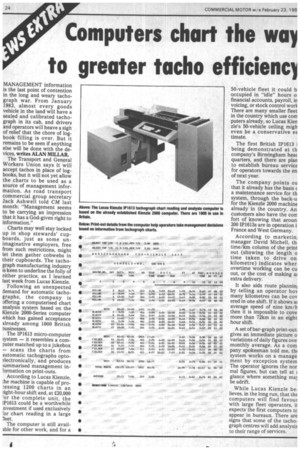Computers chart the way to greater tacho efficiency
Page 26

If you've noticed an error in this article please click here to report it so we can fix it.
MANAGEMENT information is the last point of contention in the long and weary tachograph war. From January 1982, almost every goods vehicle in the land will have a sealed and calibrated tachograph in its cab, and drivers and operators will heave a sigh of relief that the chore of logbook filling is over. But it remains to be seen if anything else will be done with the devices, writes ALAN MILLAR.
The Transport and General Workers Union says it will accept tachos in place of logbooks, but it will not yet allow the charts to be used as a source of management information. As road transport commercial group secretary Jack Ashwell told CM last month: "Management seems to be carrying an impression that it has a God-given right to information."
Charts may well stay locked up in shop stewards' cupboards, just as some unimaginative employers, free from such restrictions, might let them gather cobwebs in their cupboards. The tachograph manufacturing industry is keen to underline the folly of either practice, as I learned last week from Lucas Kienzle.
Following an unexpected demand for automatic tachographs, the company is Dffering a computerised chart analysis system based on the Kienzle 2000-Series computer which has gained acceptance already among 1000 British pusinesses.
The IP1613 micro-computer system it resembles a computer matched up to a jukebox scans the charts from automatic tachographs optoMectronically, and produces summarised management information on print-outs.
According to Lucas Kienzle, :he machine is capable of pro :essing 1200 charts in an ?.ight-hour shift and, at E20,000 or the complete unit, the [131613 could be a worthwhile nvestment if used exclusively or chart reading in a large leet.
The computer is still available for other work, and for a 50-vehicle fleet it could b occupied in "idle" hours o financial accounts, payroll, in voicing, or stock control work There are many smaller fleet in the country which use corn puters already, so Lucas Kien zle's 50-vehicle ceiling migh even be a conservative es timate.
The first British IP1613 i being demonstrated at th company's Birmingham heac quarters, and there are plan to establish bureau service for operators towards the en of next year.
The company points ou that it already has the basis c a maintenance service for th system, through the back-u for the Kienzle 2000 machine already in the country. An customers also have the con. fort of knowing that aroun 200 IP1613s are in operation i. France and West Germany.
According to marketin; manager David Michell, th time/km column of the print out (showing the length o time taken to drive on kilometre) indicates wher, overtime working can be cu out, or the cost of making ai extra delivery.
It also aids route planninl by telling an operator hay many kilometres can be coy ered in one shift. If it shows ar average speed of nine km/h then it is impossible to cove more than 72km in an eight hour shift.
A set of bar-graph print-out: gives an immediate picture o variations of daily figures ove monthly average. As a com pany spokesman told me, th( system works on a manage ment by exception system The operator ignores the nor mal figures, but can tell at glance where something ma be adrift.
While Lucas Kienzle be. lieves, in the long run, that the computers will find favour with large fleet operators, it expects the first computers tc appear in bureaux. There are signs that some of the tachograph centres will add analysis to their range of services.




































































































































